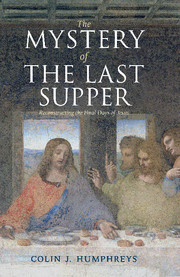Book contents
- Frontmatter
- Contents
- List of illustrations
- Foreword by I. Howard Marshall
- Acknowledgements
- 1 Four mysteries of the last week of Jesus
- 2 Dating the crucifixion – the first clues
- 3 The problem of the last supper
- 4 Can we reconstruct the Jewish calendar at the time of Christ?
- 5 The date of the crucifixion
- 6 The moon will be turned to blood
- 7 Did Jesus use the solar calendar of Qumran for his last supper Passover?
- 8 Does ancient Egypt hold a key to unlocking the problem of the last supper?
- 9 Discovering the lost calendar of ancient Israel
- 10 Was the lost ancient Jewish calendar used in Israel at the time of Jesus?
- 11 The date of the last supper: the hidden clues in the gospels
- 12 From the last supper to the crucifixion: a new analysis of the gospel accounts
- 13 A new reconstruction of the final days of Jesus
- Notes
- Bibliography
- Index of biblical and other ancient sources
- General index
7 - Did Jesus use the solar calendar of Qumran for his last supper Passover?
Published online by Cambridge University Press: 03 May 2011
- Frontmatter
- Contents
- List of illustrations
- Foreword by I. Howard Marshall
- Acknowledgements
- 1 Four mysteries of the last week of Jesus
- 2 Dating the crucifixion – the first clues
- 3 The problem of the last supper
- 4 Can we reconstruct the Jewish calendar at the time of Christ?
- 5 The date of the crucifixion
- 6 The moon will be turned to blood
- 7 Did Jesus use the solar calendar of Qumran for his last supper Passover?
- 8 Does ancient Egypt hold a key to unlocking the problem of the last supper?
- 9 Discovering the lost calendar of ancient Israel
- 10 Was the lost ancient Jewish calendar used in Israel at the time of Jesus?
- 11 The date of the last supper: the hidden clues in the gospels
- 12 From the last supper to the crucifixion: a new analysis of the gospel accounts
- 13 A new reconstruction of the final days of Jesus
- Notes
- Bibliography
- Index of biblical and other ancient sources
- General index
Summary
He [Jesus] celebrated Passover with his disciples probably according to the calendar of Qumran, that is to say, at least one day earlier [than Passover in the official Jewish calendar].
(Pope Benedict XVI's Holy Thursday Homily, Vatican City, April 6, 2007)On Easter Thursday, 2007, Pope Benedict XVI made the controversial statement quoted above. I write ‘controversial’ because, as we have seen in Chapter 3, only a small minority of biblical scholars support a different calendar solution of the synoptics/John last supper controversy. However, now that Pope Benedict, who is a fine scholar, has come out in favour of a different calendar, the Qumran solar calendar, I will give this calendar particular attention. By the end of this chapter we will know, I believe beyond reasonable doubt, whether Jesus used the Qumran solar calendar for his last Passover.
The significance of the Pope's statement should not be underestimated. It was highlighted in many newspapers around the world. For example, the UK national daily paper the Daily Telegraph stated on April 7, 2007: ‘The Pope has sought to resolve a 2000-year-old dispute about the Last Supper. Theologians have long argued over whether the meal that Jesus had with his disciples was the traditional Passover menu of roast lamb. The gospel of St John states that Jesus was crucified on the day of preparation for the Passover, the day before. St Mark says that Jesus requested a room to “eat the Passover with my disciples”.
- Type
- Chapter
- Information
- The Mystery of the Last SupperReconstructing the Final Days of Jesus, pp. 95 - 109Publisher: Cambridge University PressPrint publication year: 2011

